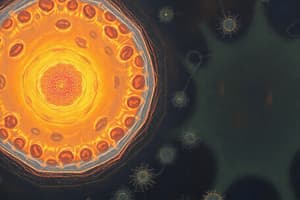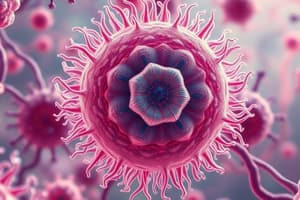Podcast
Questions and Answers
Which cell type is characterized by the absence of a nuclear membrane and membrane-bound organelles?
Which cell type is characterized by the absence of a nuclear membrane and membrane-bound organelles?
- Plant cells
- Eukaryotic cells
- Prokaryotic cells (correct)
- Animal cells
What is the approximate size of a lymphocyte?
What is the approximate size of a lymphocyte?
- 160 µm
- 6 µm (correct)
- 20 µm
- 50 µm
Which of the following structures is surrounded by a plasma membrane in eukaryotic cells?
Which of the following structures is surrounded by a plasma membrane in eukaryotic cells?
- Nucleus only
- Cell membrane and organelles (correct)
- Cytoplasm only
- Protoplasm only
What component within the eukaryotic cell is responsible for housing the genetic material?
What component within the eukaryotic cell is responsible for housing the genetic material?
Which of the following substances represents a living structure essential for cell life?
Which of the following substances represents a living structure essential for cell life?
What is the primary distinction between prokaryotic and eukaryotic cells?
What is the primary distinction between prokaryotic and eukaryotic cells?
What is the primary role of the cell membrane in both prokaryotic and eukaryotic cells?
What is the primary role of the cell membrane in both prokaryotic and eukaryotic cells?
Which of the following best describes the thickness of the cell membrane?
Which of the following best describes the thickness of the cell membrane?
What characterizes Passive Transport in cells?
What characterizes Passive Transport in cells?
What happens to a cell in a hypotonic solution?
What happens to a cell in a hypotonic solution?
Which process describes the movement of large particles into a cell via the cell membrane?
Which process describes the movement of large particles into a cell via the cell membrane?
Which solution would result in a net movement of water out of the cell?
Which solution would result in a net movement of water out of the cell?
What defines facilitated diffusion?
What defines facilitated diffusion?
Which of the following is NOT involved in Bulk Transport?
Which of the following is NOT involved in Bulk Transport?
What is the primary role of ATP in Active Transport?
What is the primary role of ATP in Active Transport?
How does osmosis primarily happen in a biological context?
How does osmosis primarily happen in a biological context?
What is the primary role of cholesterol in the plasma membrane?
What is the primary role of cholesterol in the plasma membrane?
Which component of the plasma membrane is primarily responsible for transport through channels?
Which component of the plasma membrane is primarily responsible for transport through channels?
Which function is NOT associated with the carbohydrate components of the cell membrane?
Which function is NOT associated with the carbohydrate components of the cell membrane?
What is the arrangement of phospholipids in the plasma membrane?
What is the arrangement of phospholipids in the plasma membrane?
What role do peripheral proteins play in the plasma membrane?
What role do peripheral proteins play in the plasma membrane?
How do glycoproteins and glycolipids contribute to the membrane functions?
How do glycoproteins and glycolipids contribute to the membrane functions?
Which form of transport does NOT require energy from the cell?
Which form of transport does NOT require energy from the cell?
What characteristic of the cell membrane is best described by the term 'mosaic model'?
What characteristic of the cell membrane is best described by the term 'mosaic model'?
Flashcards
Cells
Cells
The basic building blocks of all living organisms.
Prokaryotic Cells
Prokaryotic Cells
Cells that lack a membrane-bound nucleus and other organelles.
Eukaryotic Cells
Eukaryotic Cells
Cells that possess a membrane-bound nucleus and other organelles, found in plants and animals.
Cell (Plasma) Membrane
Cell (Plasma) Membrane
Signup and view all the flashcards
Protoplasm
Protoplasm
Signup and view all the flashcards
Nucleus
Nucleus
Signup and view all the flashcards
Organelles
Organelles
Signup and view all the flashcards
Inclusions
Inclusions
Signup and view all the flashcards
Passive Transport
Passive Transport
Signup and view all the flashcards
Simple Diffusion
Simple Diffusion
Signup and view all the flashcards
Osmosis
Osmosis
Signup and view all the flashcards
Isotonic Solution
Isotonic Solution
Signup and view all the flashcards
Hypotonic Solution
Hypotonic Solution
Signup and view all the flashcards
Hypertonic Solution
Hypertonic Solution
Signup and view all the flashcards
Facilitated Diffusion
Facilitated Diffusion
Signup and view all the flashcards
Active Transport
Active Transport
Signup and view all the flashcards
What is the cell membrane?
What is the cell membrane?
Signup and view all the flashcards
What is protoplasm?
What is protoplasm?
Signup and view all the flashcards
How are phospholipids arranged in the cell membrane?
How are phospholipids arranged in the cell membrane?
Signup and view all the flashcards
What is the role of cholesterol in the cell membrane?
What is the role of cholesterol in the cell membrane?
Signup and view all the flashcards
What is the role of proteins in the cell membrane?
What is the role of proteins in the cell membrane?
Signup and view all the flashcards
What are integral proteins?
What are integral proteins?
Signup and view all the flashcards
What are peripheral proteins?
What are peripheral proteins?
Signup and view all the flashcards
What is the glycocalyx?
What is the glycocalyx?
Signup and view all the flashcards
Study Notes
The Cell (I)
- All living things are made of one or more cells.
- Cells are the smallest units of living things.
- The human body contains many different types of cells.
- All cells share basic characteristics, such as being enclosed by a cell membrane, capable of respiration, reproduction, and growth.
- Cells vary in function, shape, and size.
- Examples of cell shape variation include: rounded, oval, flat, cubical, columnar, spindle or fusiform.
- Examples of cell size variation: lymphocyte (6µm) and fat/ova cells (160µm).
Cell Types
- Cells are categorized into prokaryotic and eukaryotic cells.
- Prokaryotic cells lack a nuclear membrane or other membrane-bound organelles within their cytoplasm, and are surrounded by a cell wall .
- Examples include bacteria and blue-green algae.
- Eukaryotic cells possess a nuclear membrane and membrane-bound organelles in their cytoplasm.
- They are surrounded by a cell membrane (plasma membrane).
- Examples include plant and animal cells.
Eukaryotic Cell Possessions
- Cell (plasma) membrane: A thin membrane (7.5-10 nanometers thick) separating the intracellular and extracellular environments.
- Protoplasm: A fluid-like material encompassing the cell's contents; including:
- Cytoplasm (cytosol): The protoplasm surrounding the cell nucleus.
- Nucleoplasm: The protoplasm within the nucleus.
- Organelles: Living structures crucial for cellular functions.
- Inclusions: Non-living accumulations of metabolites or cell products.
- Other substances: Water (75%), proteins, carbohydrates, lipids, nucleic acids, and minerals.
- Nucleus: A prominent organelle containing genetic material.
Cell Structure
- Protoplasm: Includes the entire contents of the cell—the nucleus and the cytoplasm (cytosol).
- Cell membrane: Surrounds the entire protoplasm.
- Cytoplasm (cytosol): The fluid portion of the cell, outside of the nucleus.
- Nucleus: Contains the nucleoplasm, where the cell's genetic information resides.
- Organelles: Small structures within the cytoplasm performing specific functions.
Cell Membrane (Plasma Membrane)
- A very thin membrane (7.5-10 nm thick)
- Separates the intracellular from the extra cellular environments.
- Not visible with a light microscope, but visible with an electron microscope.
- Composed of:
- A bilayer of phospholipids.
- Proteins.
- Cholesterol.
- Short chains of sugars (glycoproteins and glycolipids).
- The membrane is flexible due to the lateral movement of phospholipids and proteins.
Molecular Structure of the Cell Membrane
- Phospholipid bilayer: Two layers of phospholipids.
- Polar heads face outward, interacting with water.
- Nonpolar tails face inward, avoiding water.
- Cholesterol embedded within the bilayer regulates membrane fluidity.
- Peripheral proteins: On the surface of the membrane.
- Integral proteins: Span the membrane, possibly acting as channels or carriers.
Cell Membrane Lipids
- Phospholipids: Have a polar (hydrophilic) head and nonpolar (hydrophobic) tails.
- The hydrophilic heads face outward and the hydrophobic tails face inward.
- Cholesterol: Embedded in the phospholipid bilayer.
- Regulates membrane fluidity.
The Proteins of Cell Membrane
- Globular proteins embedded in the phospholipid bilayer.
- Integral proteins: Span the membrane;
- Transmembrane proteins: Span the entire membrane (e.g., ion channels)
- Monotopic proteins: Embedded into one side of the membrane (e.g., enzymes).
- Peripheral proteins: Loosely attached to the membrane surface.
Functions of Proteins of the Cell Membrane
- Structure support.
- Transport of molecules (channels or carriers).
- Cell-cell recognition.
- Receptors for hormones and antigens.
- Enzymatic control of chemical reactions.
The Carbohydrates of Cell Membrane
- Attached to membrane proteins (glycoproteins) and lipids (glycolipids).
- Form the glycocalyx (cell coat).
- Functions:
- Cell adhesion (binding cells to each other).
- Cell-cell recognition (e.g., distinguishing self from non-self cells).
Transport Across Cell Membrane
- Movement can be passive or active.
- Passive Transport:
- Simple diffusion: Movement of small molecules (e.g., O2, CO2) from high concentration to low concentration across a semi-permeable membrane.
- Osmosis: Movement of water from high concentration to low concentration across a selectively permeable membrane.
- Facilitated diffusion: Large or charged molecules (e.g., ions, glucose, amino acids) move through membrane proteins.
- Active Transport: Uses energy (ATP) to transport molecules against their concentration gradient.
Bulk Transport
- Endocytosis: Active transport of large particles into the cell.
- Phagocytosis: Cell eating (taking in solid particles).
- Pinocytosis: Cell drinking (taking in liquid particles).
- Receptor-mediated endocytosis: Specific molecules bind to receptors on the membrane.
- Exocytosis: Active transport of molecules out of the cell.
Solutions and Osmosis
- Isotonic solution: Concentration of solutes same inside and outside the cell.
- Hypertonic solution: Higher concentration of solutes than inside the cell.
- Hypotonic solution: Lower concentration of solutes than inside the cell
Studying That Suits You
Use AI to generate personalized quizzes and flashcards to suit your learning preferences.




